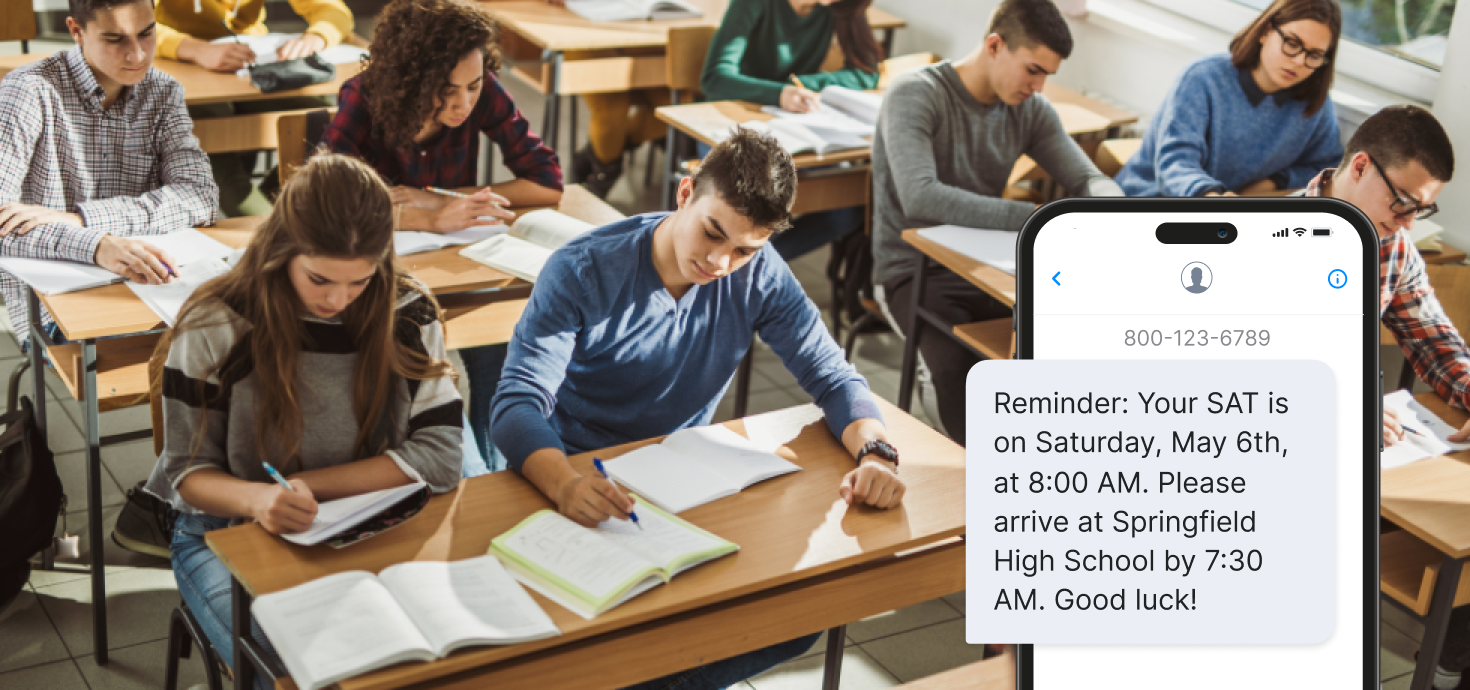
SMS gets opened by 82% of recipients within minutes. Email reaches 4.26 billion users with unmatched depth and personalization. Those stats are impressive, but when you combine these channels, something extraordinary happens.
The numbers don’t lie: Businesses using SMS and email together see 429% higher conversion rates than email alone. It’s not about choosing sides. It’s about understanding that your customers live in a multi-channel world, and your communication should too.
In this deep dive into 2025 messaging statistics, we’ll show you why successful businesses stopped treating SMS and email as separate channels and started orchestrating them as unified strategy.
Overview of SMS & email statistics in 2025
In 2025, SMS and email marketing continue to grow, proving essential to any modern strategy. Email marketing continues to deliver a high return on investment (ROI), with an average of $42 earned for every $1 spent.
- 3 minutes on average is the typical SMS response time.
6.92 billion is the current global population of smartphone users, indicating that approximately 86.29% possess a smartphone.
6 billion people own mobile phones, meaning 65% of the global population, etc.
- Only 39% of businesses have incorporated SMS into their digital marketing strategy.
- In 2025, 72% of consumers prefer to receive promotional content via email over other channels, including social media
- 89% of consumers find at least one type of business SMS valuable (especially reminders and shipping updates), underscoring the role SMS still plays in delivering timely, relevant content.
Many businesses are still underutilizing SMS and email, despite their exceptional reach and engagement with audiences when they’re most receptive.
SMS & email usage and adoption trends
SMS and email remain dominant forms of communication. While SMS thrives in low connectivity areas, email remains a trusted, low-bandwidth tool for personal and professional communication. Here’s the data to back it up:
-
75% of consumers express a clear preference for text-based customer support interactions over traditional phone calls or social media interactions.
- Businesses using SMS + email retain 89% of customers vs. 33% with one channel
- 98% of people read or react to the texts they receive
- 9 out of 10 consumers still read SMS (only 8% ignore it), making it one of the most consistently viewed communication formats available.
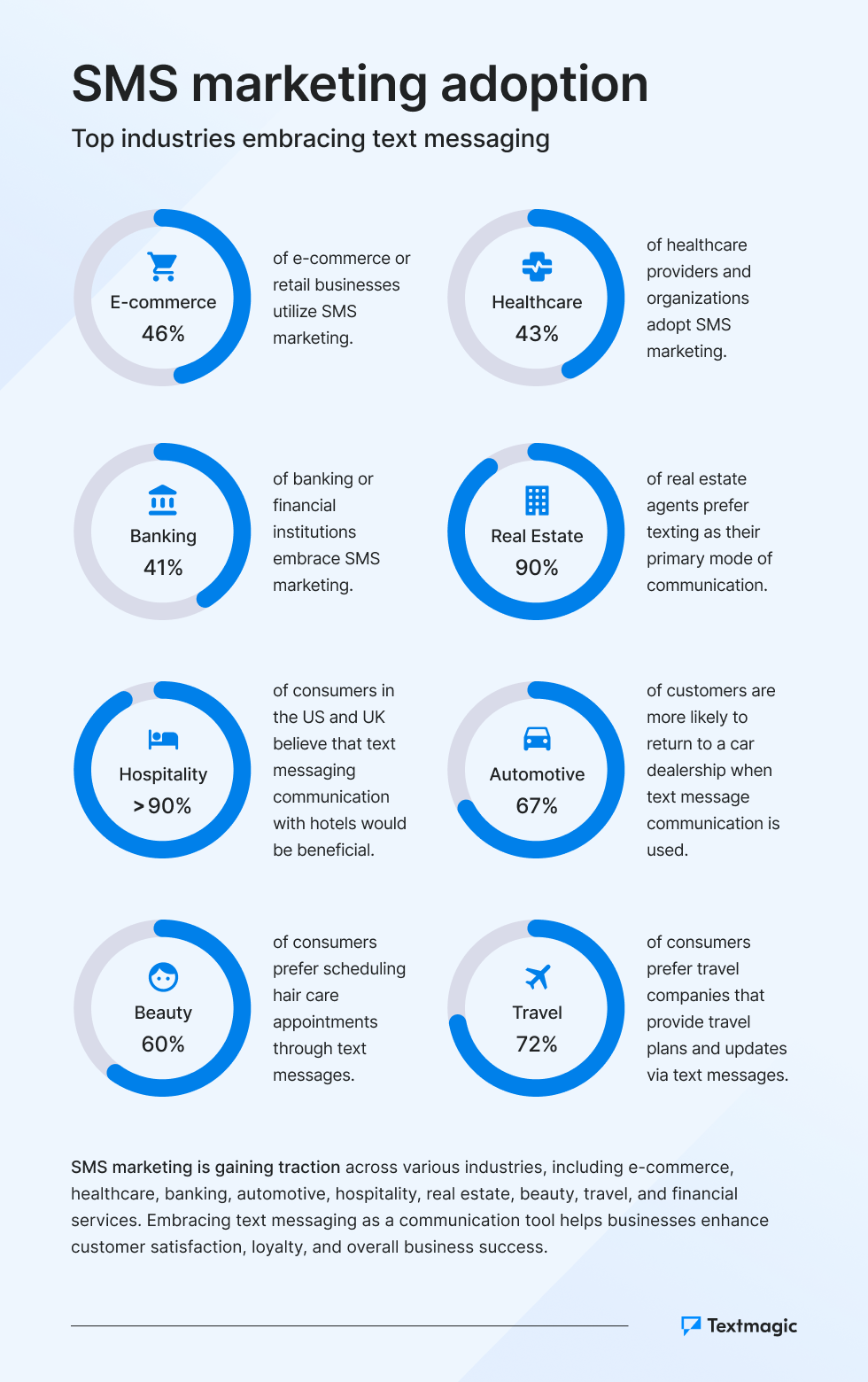
SMS & email adoption across different industries
From retail and healthcare to finance and hospitality, industries across the board have embraced SMS and email as powerful tools for keeping customers in the loop and making service feel effortless and personal.
Three prominent industries show a higher inclination to opt-in for text messages:
- E-commerce or retail (46%),
- Healthcare (43%),
- Banking or financial institutions (41%).
-
67% of consumers express a firm intention to revisit a car dealership for paid service work when text message communication is used compared to phone contact.
-
Over 90% of consumers in the US and UK believe that text messaging as a means of communication with hotels would be either “very” or “somewhat” beneficial.
-
90% of real estate agents chose texting as their preferred mode of communication.
- Healthcare organizations report that text message reminders reduce no-shows by up to 40%, which aligns with consumer preferences, as appointment reminders (31%) were ranked as the most valuable type of SMS, followed by shipping updates and discount offers.
- The e-commerce sector experienced the largest boost in email deliverability, with rates rising 10.28% and bounce rates dropping 0.7%.
SMS & email as communication channels
Next, let’s compare text messaging to other marketing channels and see how they stack up next to each other:
-
Text messages exhibit an impressive response rate that surpasses phone calls, emails, and Facebook messages by 209%.
- An estimated 60% of customers read text messages within 1 to 5 minutes of receiving them.

- 63% of U.S. customers prefer texting with businesses rather than voice communication.
- 23 hours are spent on average each week by Americans for texting activities, while their phone calls account for less than 15 minutes per day.
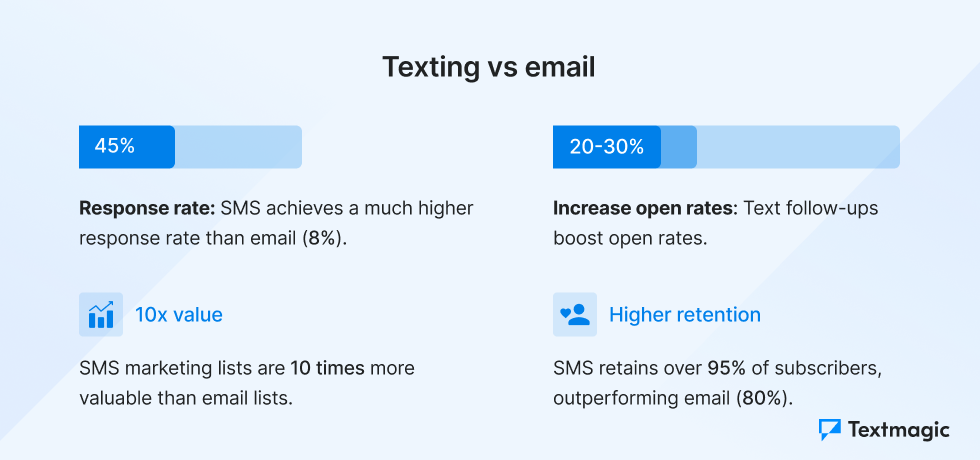
A 20-30% increase in open rates is due to sending a text follow-up to an email, as reported by Adobe. This strategy shows that combining SMS with email can enhance the overall effectiveness of marketing campaigns.
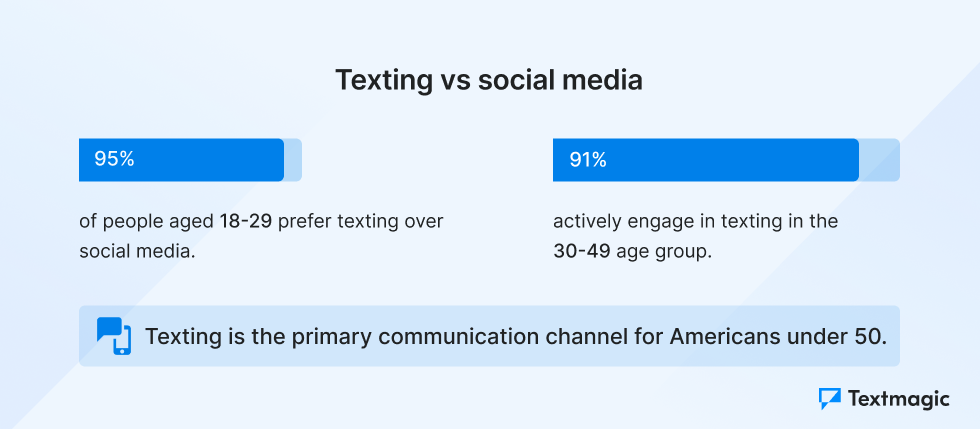
-
95% of people aged 18-29 chose texting as their preferred mode of communication, while social media engagement stands at 90%.
- 91% of people aged 30-40 actively engage in texting, whereas their social media usage is at 82%. It can be concluded that texting is the primary communication channel for Americans under the age of 50
-
33% of American adults express a preference for text messages over any other forms of communication.
- 60% of consumers prefer to be contacted by brands through email, making it a favored communication channel.
- Segmented and personalized emails generate 58% of all revenue.
Effectiveness of SMS & email marketing
SMS and email marketing are highly effective channels because they’re fast, personal, and get seen, without blowing your budget or crossing boundaries.
Conversion rates and ROI of SMS campaigns
- The average conversion rate for SMS marketing ranges between 20% to 30%, depending on the industry and campaign specifics
- Email marketing sees average conversion rates between 2% to 5%, depending on factors like industry, audience, and campaign quality
Open rates and engagement levels of SMS messages
91% of customers opt-in for receiving text messages from businesses.
82% is the average SMS open rate, compared to email open rates (21%).
- Customers respond 7x more to sms (45%) compared to email (6%).
Together, SMS and email offer the perfect balance of speed, reach, and personalization. Double your channels, double your impact. Without doubling your spend.
Mobile and consumer behavior
Let’s explore some key aspects of mobile consumer behavior and its impact on SMS and email communication.
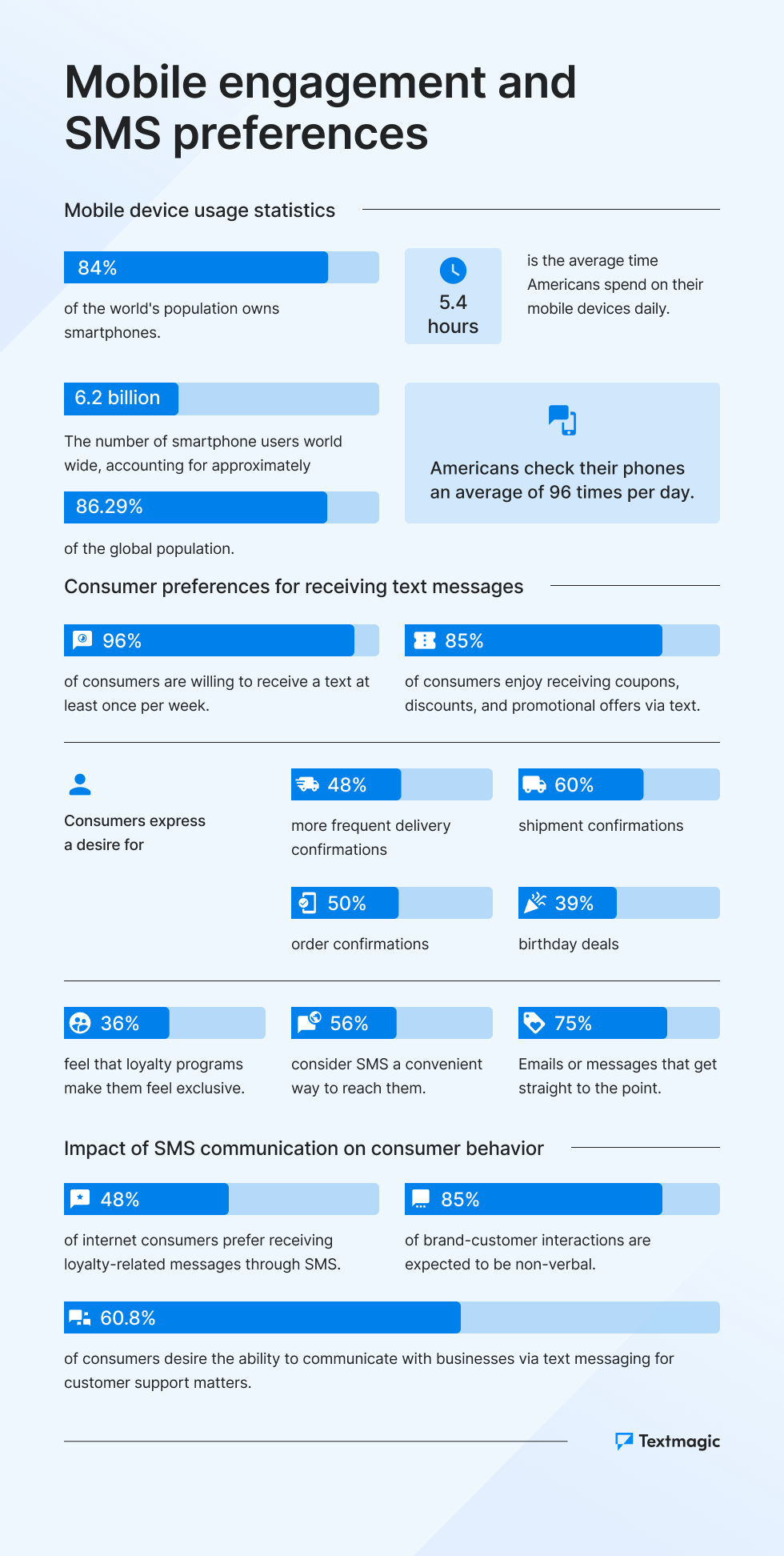
Consumer preferences for receiving email & texts
- 96% of consumers reported willingness to receive a text at least once per week, according to a study conducted by Klaviyo.
- 48% of consumers enjoy coupons, discounts, and promotional offers via text.
- 64%would like to receive delivery confirmations more often,
- 60% would like to receive shipment confirmations,
- 50% would like to receive order confirmations,
- 39% of responders would enjoy receiving birthday deals.
- 36% of consumers feel that loyalty programs and benefits make them feel part of an exclusive group.
- 56% of consumers consider texting to be a convenient way to reach them, regardless of their location.
- Over 75% of consumers prefer emails that get straight to the point, proving that less really is more, especially on a small screen.
- Emails with personalized subject lines are 26% more likely to be opened, proving that if it’s not personal, it’s probably getting ignored.
- 81% of small businesses rely on email as their primary customer acquisition channel, and 80% for retention, reminding us that when it comes to staying in touch, email still does the heavy lifting.
Impact of personalized and timely communication on consumer behavior
Personalized and timely communication through SMS and email has a powerful impact on consumer behavior. Together, they keep your brand in the inbox, in the message thread, and in your customer’s mind.
-
48% of internet consumers have expressed a clear preference for receiving loyalty-related messages through SMS.
85% of brand-customer interactions are expected to be handled without the need for verbal communication
60.8% of consumers express a strong desire for the ability to communicate with businesses via text messaging for customer support matters.
- Campaigns using both SMS & email convert 429% better than email alone
- Emails with personalized content see transaction rates that are six times higher than non-personalized ones, highlighting the effectiveness of personalization in email marketing.
More text messaging stats from Textmagic customers
Below are some relevant stats from Textmagic users, that show the high-engagement of two-way text messaging. It also shows more opportunity for businesses to implement personalization features into their SMS marketing campaigns.
| Parameter | Value |
|---|---|
| Average reply rate for users engaging in 2-way communication | 50.17% |
| Average reply rate for all B2B text communications | 7.13% |
| Outbound texts with SMS links | 26.9% |
| Outbound texts that use personalization | 7.9% |
| Average monthly texts volume | 21 million |
Future trends and predictions
The SMS and email marketing industries continue to evolve, shaped by new technologies and shifting consumer expectations. Businesses want faster, more personal ways to connect, and SMS and email are rising to meet the moment. Let’s check some key insights:
Here are the key technologies driving their evolution:
- Artificial intelligence (AI): Thanks to AI, businesses can use SMS and email to provide fast answers, personal support, and even help customers check out in just a few steps. This ensures fast, scalable, and consistent communication.
- IoT devices (Internet of Things): Whether it’s a sensor or a smart home device, IoT tech can fire off real-time updates through SMS or email. Both channels help bridge the gap between devices and end users.
- Mobile payments and security: With more people banking on their phones, SMS and email help keep things secure by delivering instant alerts and verifications.. These channels enhance both convenience and security, ensuring smooth and trusted financial interactions.
That said, consumer trust remains fragile: 52% of users say that requests for personal information in texts immediately raise red flags.
Predictions for the growth and evolution of SMS & email
Beyond Market Insights predicts that the market for application-to-person (A2P) SMS messaging will experience substantial growth, rising from 62.2 billion in 2021 to 89.2 billion by 2030.
This represents a compound annual growth rate (CAGR) of 4.1% between 2022 and 2032. This growth highlights the continued relevance of direct communication channels like SMS, especially when paired with email, which remains a trusted, high-performing channel.
$9.96 billion: how much the SMS marketing industry is projected to be worth by 2030 in the U.S., indicating its growing significance in the marketing landscape.
60% of business owners have intentions to boost their budget allocated for SMS marketing.
Email marketing revenue is projected to reach $11.3 billion in 2025, reflecting its effectiveness in driving sales and engagement across industries.
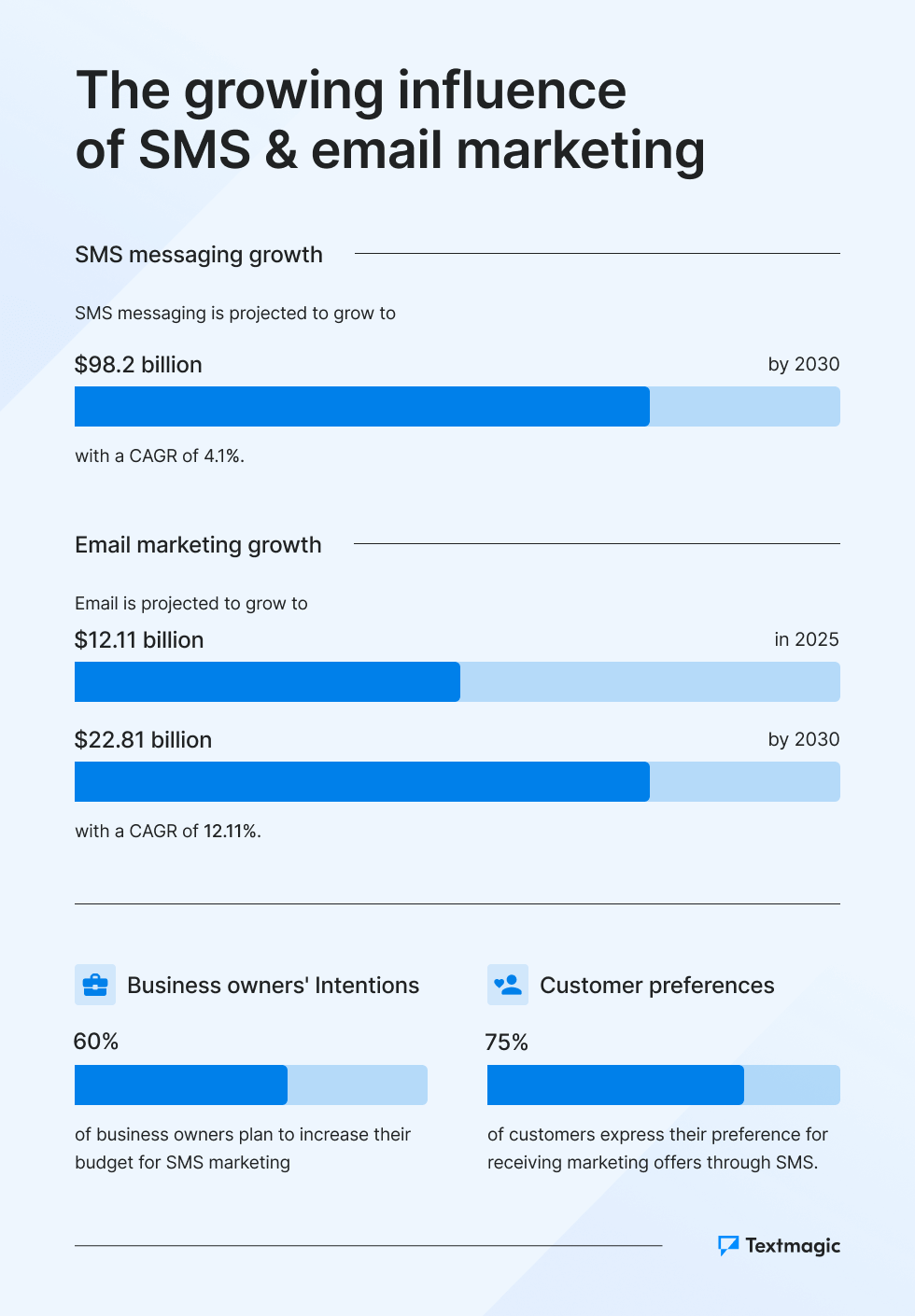
What does this all mean for you?
Leveraging both SMS and email in business communication provides a powerful, cost-effective way to get your message out there. It also ensures your message lands and sparks real conversations. Here’s a quick, compelling look at the data that proves it:
- 86.1% of recipients promptly open SMS messages within 30 minutes of receiving them.
- The average email open rate across all industries is approximately 39.7%.
When businesses use both SMS and email, they connect better, work smarter, and see stronger results that leave guesswork (and ghosted campaigns) behind.
Frequently Asked Questions (FAQs)
Absolutely not. SMS’s role is evolving rather than fading away.
Many companies use SMS alongside emails and social media as part of their omnichannel strategy. Its high open rates and immediate delivery make it a key part of customer outreach efforts.
A text message feels more one-on-one than a social media post or a mass email. Its broad compatibility means you can reach almost anyone, regardless of device or location.
The numbers speak for themselves: 98% of SMS messages get opened, and 29% turn into conversions. This high visibility and action rate make SMS a great channel for campaigns that need to deliver fast and measurable results.
One of the biggest challenges in SMS marketing is staying compliant with privacy and communication laws like GDPR, TCPA, and CAN-SPAM. You must obtain clear consent before sending messages and provide simple opt-out options.In 2025, SMS and email marketing continue to grow, proving essential to any modern strategy. Email marketing continues to deliver a high return on investment (ROI), with an average of $42 earned for every $1 spent.
Related articles
Communication breakdown: What it is and how to avoid it
Discover practical strategies to prevent and swiftly...
What is call masking and how can it benefit your business?
Have you ever had to call your food delivery courier...
Text messaging for schools: Improving communication with SMS
Text messaging helps provide timely and accessible i...
How to use text messaging for your wedding planning business
As a wedding planner, your job is to eliminate the s...
5 Ways to get the most out of your Textmagic trial
Not sure if business texting is right for you? Sign ...


